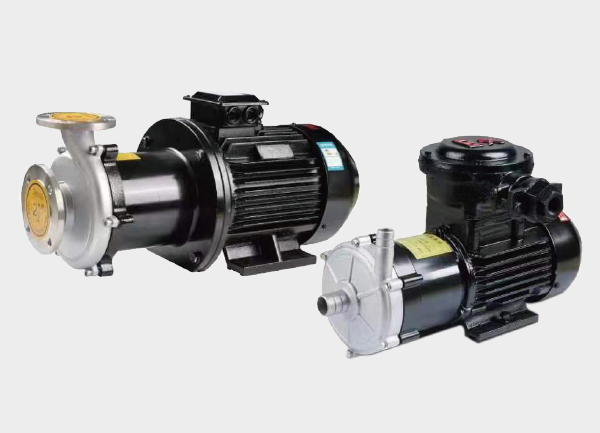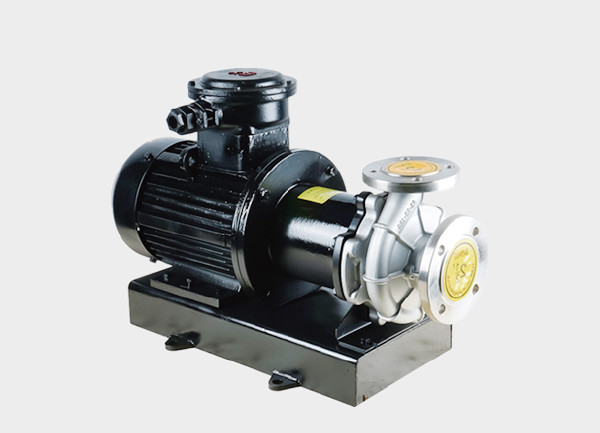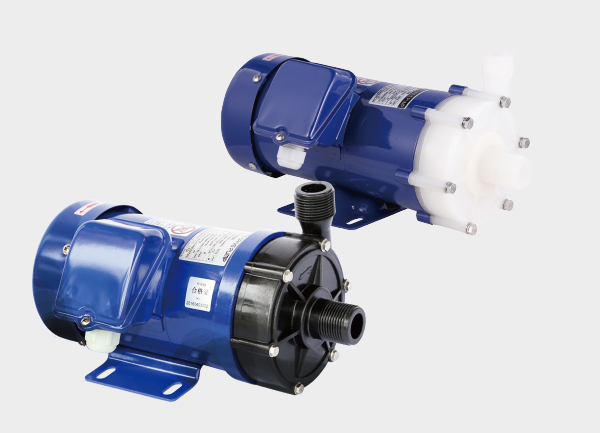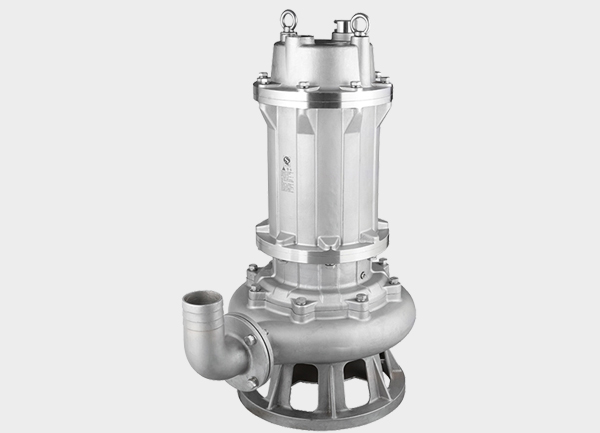In industrial fluid transfer, leak prevention, media compatibility, and operational stability are critical demands. The magnetic drive pump (commonly known as a magnetic pump) addresses these needs through a sealless design that eliminates mechanical seals and leakage risks. Over time, it has evolved into multiple specialized subtypes to meet the diverse requirements of chemical, pharmaceutical, and environmental industries.
This article explores the main categories of magnetic drive pumps, their core technologies, and industrial applications.

1. Core Principle — The Sealless “Safety Code”
At the heart of a magnetic drive pump is the magnetic coupling transmission system. The motor drives an outer magnetic rotor, which transfers torque through a sealed isolation sleeve to the inner magnetic rotor, making the impeller rotate synchronously.
By removing the traditional mechanical seal, the pump forms a completely enclosed chamber, eliminating the risk of leakage caused by wear and tear. This innovation makes it ideal for transferring toxic, flammable, explosive, or high-purity fluids — forming the foundation of what’s known as the “sealless magnetic pump.”
Rather than representing one single model, this principle defines an entire family of magnetic drive technologies.
2. Segmented by Application: Purpose-Built Magnetic Drive Pumps
(1) Magnetic Drive Chemical Pump — The Guardian Against Corrosion
In chemical processing, where strong acids, alkalis, and solvents are common, magnetic drive chemical pumps are optimized with corrosion-resistant materials (such as fluoroplastics and Hastelloy) and reinforced magnetic couplings.
They safely handle aggressive media such as hydrochloric acid, sulfuric acid, and methanol, widely used in reaction feed systems, pesticide manufacturing, and dye synthesis.
By removing mechanical seals, these pumps prevent chemical leaks that could cause safety hazards or environmental contamination.
(2) High-Temperature Magnetic Drive Pump — The Heat-Resistant Pioneer
When fluid temperatures exceed 150°C (e.g., thermal oil, molten salts, or condensate), standard magnetic pumps face risks like demagnetization or deformation.
High-temperature magnetic pumps counter this with two design upgrades:
Use of rare-earth SmCo magnets that retain strong magnetic fields at elevated temperatures.
Integration of cooling systems (such as jacketed or internal circulation cooling) to manage rotor and isolation shell temperatures.
They are widely used in petrochemical refining, heat recovery, and thermal oil circulation, withstanding temperatures above 400°C.
(3) Industrial Magnetic Pump — The All-Purpose Performer
The industrial magnetic pump serves general-purpose applications under moderate pressure and temperature (−40°C to 120°C).
Compact, low-maintenance, and versatile, it handles water, light oils, and diluted acids/alkalis in industries such as power generation, food processing, and electronics manufacturing — forming the entry-level solution for leak-free fluid transfer.
3. Classified by Structure and Function: Tailored for Specific Flow Characteristics
(1) Magnetic Gear Pump vs. Magnetic Centrifugal Pump
Magnetic Gear Pump:
Uses intermeshing gears to move fluid through displacement, delivering stable flow, high pressure, and self-priming capability. Ideal for viscous media such as lubricants, resins, or adhesives. Common in lubrication systems, ink delivery, and adhesive production.Magnetic Centrifugal Pump:
Relies on impeller-driven centrifugal force to move low-viscosity fluids with high flow rates and broad head range. Suited for cooling water systems, wastewater treatment, and pharmaceutical solutions — the mainstream choice for high-flow, low-viscosity applications.
(2) Self-Priming Magnetic Drive Pump — Simplifying Low-Level Transfer
Traditional magnetic pumps require manual priming before operation.
The self-priming magnetic pump features an internal gas-liquid separation chamber and recirculation path, allowing it to automatically evacuate air and start without pre-filling.
It’s ideal for tank unloading, low-level suction, and intermittent operations, commonly seen in petrochemical unloading stations and food-grade tank drainage systems.
(3) Magnetic Circulation Pump — The Closed-Loop Specialist
Designed for low head, high flow, and continuous circulation, the magnetic circulation pump serves closed-loop systems such as industrial cooling, reactor temperature control, and electronic device heat management.
Its streamlined hydraulic design minimizes resistance and energy loss, extending maintenance intervals up to 1–2 years.
4. Material Selection Strategies: Adapting to Different Media
(1) Plastic Magnetic Drive Pump — Lightweight and Cost-Effective
Constructed from PP, PVDF, or PTFE plastics, these pumps are lightweight, economical, and corrosion-resistant to weak acids and alkalis.
They are widely used in environmental wastewater treatment, electroplating rinsing, and agricultural fertilizer dosing.
However, they have limited temperature (≤80°C) and pressure (≤1.6MPa) tolerance, making them unsuitable for high-stress or high-corrosion operations.
(2) Stainless Steel Magnetic Drive Pump — The Durable High-End Choice
Built from 304, 316L, or duplex stainless steel, these pumps resist strong acids, high pressure (≤4.0MPa), and temperatures up to 200°C.
They are preferred in chemical, pharmaceutical, and food-grade industries.
For example, 316L magnetic pumps handle nitric acid and acetic acid, while sanitary stainless models meet GMP hygiene standards for pharmaceuticals and beverages.
5. Conclusion: Industrial Value and Future Trends
From its sealless design that eliminates leakage to its application-specific variants, the magnetic drive pump has become a cornerstone of safe and efficient industrial fluid handling.
Looking ahead, new industries such as lithium battery manufacturing and semiconductors are driving demand for:
Higher precision (low-pulsation transfer)
Extreme condition adaptability (ultra-high or ultra-low temperatures)
Smart functionality (online monitoring and fault diagnostics)
The next generation of magnetic drive pumps will thus move toward intelligent, high-performance, and sustainable solutions — expanding the boundaries of industrial fluid transport.







